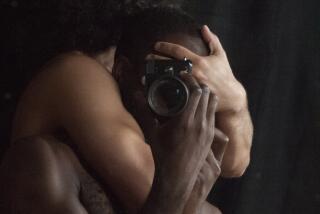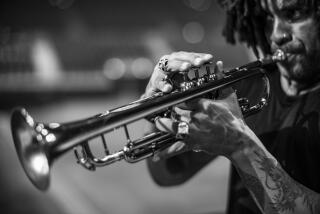Andrew Moore’s Cuba photos at Couturier Gallery evoke the bittersweet
- Share via
In one of Andrew Moore’s photographs of Cuba, on display through Feb. 15 at Couturier Gallery in Los Angeles, a half-dozen men and women are hanging out at an aging ferry terminal.
Their postures are casual and unself-conscious, yet they form a quasi-theatrical tableau. One couple appears absorbed in intimate conversation. A single man rests his head on his hands. Through the modest structure’s three arched openings, the verdant tropical landscape can be glimpsed.
The image is titled “La Espera,” a Spanish word that can mean both “wait” and “hope.” No further commentary is needed to evoke the bittersweet mood that pervades the prints on display as well as in Moore’s just-published oversize book, “Cuba.”
Moore is something of a connoisseur of time’s melancholy, corrosive effects on buildings, cities, human beings. His haunting book of images, “Detroit Disassembled,” captures the Motor City in all the tattered grandeur of its postindustrial decline. Mainly devoid of any human presence, his Detroit pictures allow abandoned railway terminals and ruined movie houses to speak for themselves.
CRITICS’ PICKS: What to watch, where to go, what to eat
“It’s the way architecture represents history and the way buildings tell the story of our times, and the way they are kind of a witness to our times,” says Moore, who makes his home in New York. “Whether that’s a reliable witness or not, they definitely bear witness.”
By contrast, his new book of Cuba photos conjures the hardships but also the teeming humanity of the Caribbean island nation. In one portrait, two handsome, intense-looking young men, posing with their crude, hand-made boogie boards beside the gray surf, suggest a pair of scarred warrior-knights nobly bearing their shields into battle.
Another image depicts the decrepit interior of one of Cuba’s countless colonial-era edifices, reborn during the Castro era as a barbershop. A painting of the Sacred Heart of Jesus bears watch over the barber and his customer, while in a baroque touch worthy of Diego Velázquez, a side mirror reveals another man hovering somewhere outside the camera frame.
“I really like kind of being a detective,” Moore says. “I like to follow leads and getting into places and talking to folks. That’s why Cuba was so fun, because pretty much any door you knocked on, somebody would welcome you into their house.”
Yet another image of a living room, though it contains no people, summons their presence through its composition: the humble mismatched furniture, the non-working Russian-made television, the salvaged odds and ends that pass for decor.
“There wasn’t any scrap of material that wasn’t repurposed, reused, reconfigured in some sort of way,” Moore observes. In Cuba, he says, there’s always “this mixture of high and low, of the elegant and the improvised.”
Decades before Fidel Castro’s revolutionary army toppled the Batista dictatorship, Cuba was an enticing subject for foreign photographers, most notably Walker Evans, who went to Havana on assignment in the 1930s. But whereas Evans, ever the photographer-flâneur, kept a certain detachment from his Cuban subjects, Moore’s images manifest a palpable empathy.
More to Read
The biggest entertainment stories
Get our big stories about Hollywood, film, television, music, arts, culture and more right in your inbox as soon as they publish.
You may occasionally receive promotional content from the Los Angeles Times.











